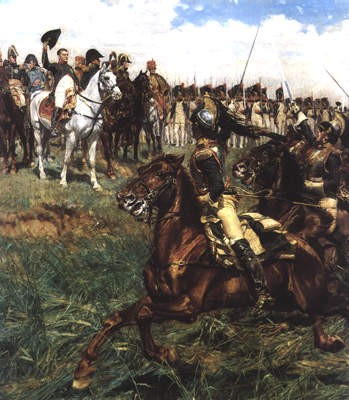On 4 July, 1866, a group of Americans in Paris were celebrating their national holiday in a restaurant called the “Bois de Boulogne”. At this meal, John Jay, the son of an eminent lawyer, gave a speech proposing that he and his companions should get together to create “a national institution and art gallery” in New York. The project was welcomed with great enthusiasm and a plan was formulated whereby the work was to be overseen by the Union League Club with Jay as its president. As a result of the generous donations of public figures, collectors and philanthropists, the Metropolitan Museum of Art opened its doors on 13 April, 1870.
In 1880, the museum was to find its final resting place on the edge of Central Park on 5th Avenue. The building itself has been steadily enlarged over the twentieth century. In 1902 a central pavilion was added by Hunt to the Neoclassical façade –
incidentally the curious un-worked blocks of stone atop the three paired Corinthian columns and capitals were destined for statuary groups which still today await finishing. Over the period 1911-1913 the architects MacKim, Mead and White added the North and South wings. Kevin Roche and Dinkeloo enlarged the building still further in 1975, 1979, 1980, 1982 and 1987 when they added (respectively) the Lehman Wing, the Saekler Wing, the American Wing, the Rockefeller Wing and the
Acheson-Wallace Wing. Today the museum covers almost 45 hectares and as such represents one of the largest museums in the world.
The Met, as it is affectionately known, is not merely a collection of artefacts, it is a 'collection of museums', to use the expression coined by the museum's director Philippe de Montebello. Housing as it does more than three million works of all types, the Met is an encyclopaedia of the world of art, with all cultures represented. And despite the fact that there is no specific Napoleon or Second Empire gallery, there is nevertheless plenty to interest the Napoleonic enthusiast in the different sections devoted to the arts of the 19th century.
As for painting under the Ancien Régime there are works by the female artists Labille-Guiard and Vigée-Lebrun, most notably by the latter a 1783 portrait of Catherine Noëlle Worlee, the future Madame de Talleyrand. There are also some of David's most important early paintings, notably The Death of Socrates presented at the Salon of 1787 which by its Republican symbolism prefigured the events of the Revolution. Two works show particularly David's skill as a portrait painter, namely a very beautiful rendering of Monsieur and Madame Lavoisier of 1788 and a fine portrait of Maréchal Gerard of 1816. A work by Prud'hon, Andromache and Astyanax, a commission of the Empress Marie-Louise, is clearly an evocation of the young king of Rome and his mother after the fall of Napoleon. There are two fascinating paintings by Ingres dating from the First and Second Empires respectively. The first, Joseph-Antoine Moltedo, gives a portrait of the director of the postal service in Rome during the period 1803-1813. The work is one of a series painted between 1810 and 1814 which was consecrated entirely to French officers in Napoleonic Rome. The second, The Princess de Broglie, a portrait of 1835, is an extraordinary representation of feminine beauty à la Ingres. Spanish painting is represented by abundant examples of Goya, and the same is true for English painting, with many works by Reynolds, Gainsborough, Romney, Constable and Turner.
The art of the Second Empire appears in many different guises. There is the Realism and Naturalism of Rosa Bonheur, Rousseau, Millet, Corot, Manet and Courbet, the latter of whose Woman with Parrot was nearly bought in 1886 by Nieuwerkerke, the Imperial Superintendant of Fine Arts for Napoleon III, for the imperial museums. There is the nascent Impressionism of Monet (The Terrace at Sainte-Adresse, 1867; La grenouillère, 1869), and some early Symbolist works, notably Oedipus and the Sphinx
by Gustave Moreau, bought in 1864 by Prince Napoleon. There is also some Academism with Meissonier (Friedland, 1807) and Winterhalter (The Empress Eugénie).
Of the many excellent sculptures, there is only enough space here to cite but a few. Canova's Perseus with the Gorgon's Head was sculpted between 1790 and 1800 and took the ancient Belvedere Apollo (removed from the Vatican by Napoleon) as its inspiration. Bought by Pope Pius VII, this was to replace the famous antique statue until its return to its rightful owner. Carpeaux is also represented at the Met with his
marble of Ugolin and a very moving bust of Napoleon III. This statue begun in exile in 1871 was only finished in Chiselhurst a few days before the Emperor's death, 9 January, 1873.
The decorative arts department has numerous pieces of great worth both from the First and Second Empires. Of particular note are certain complete restorations of interiors and a tapestry which Napoleon commissioned from the Gobelins manufactory and gave to Cambacérès. On it, Napoleon appears in his coronation robes as painted by François Gérard. Finally the Institute of Costume (founded in 1937) owns a remarkable collection of models dating from the Revolution, Consulate and Empire periods.
K.H. trans P.H.


